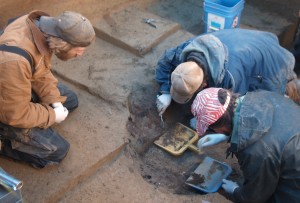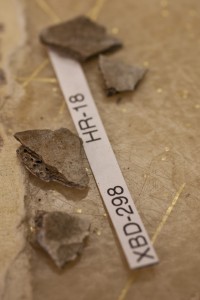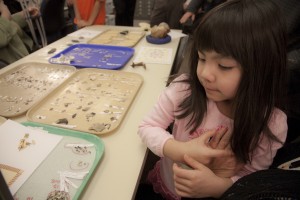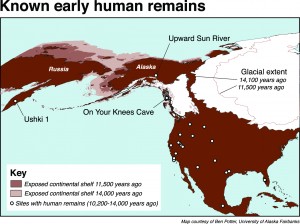Oldest subarctic North American human remains found
February 24, 2011

Marmian Grimes
907-474-7902
2/24/11
A newly excavated archaeological site in Alaska contained the cremated remains of one of the earliest inhabitants of North America. The site may provide rare insights into the burial practices of Ice Age people and shed new light on their daily lives.
University of Alaska Fairbanks archaeologist Ben Potter and four colleagues published their discovery in the Feb. 25 edition of the journal Science.
The skeletal remains appear to be that of an approximately three-year-old child, found in an ancient fire pit within an equally ancient dwelling at the Upward Sun River site, near the Tanana River in central Alaska. Radiocarbon dating of wood at the site indicates the cremation took place roughly 11,500 years ago, when the Bering Land Bridge may still have connected Alaska and Asia. Initial observations of the teeth by UAF bioarchaeologist Joel Irish provide confirmation that the child is biologically affiliated with Native Americans and Northeast Asians.

The apparent age of the remains from the site, researchers said, would certainly make them the oldest human remains found in northern North America as well as the second-youngest Ice Age child on the continent.
The find is also notable because archaeologists and Alaska Natives are working hand-in-hand to ensure the excavation and subsequent examination of the remains will benefit science and heritage studies in a way that is respectful of traditional Athabascan culture.
"This site reflects many different behaviors never before seen in this part of the world during the last Ice Age, and the preservation and lack of disturbance allows us to explore the lifeways of these ancient peoples in new ways," said Potter.
Both the burial and the house itself are the earliest of their kind known in subarctic North America, according to the researchers. Discovery of burial sites of this age in North America is very rare; the buried remains of children are even more so.
The discovery of the remains was unexpected, Potter said. In fact, it was evidence of an older occupation at the site—about 13,200 years ago—that first attracted the researchers to the site. Only while investigating this earlier occupation did evidence of the burial come to light.
The initial excavation of the site was supported by the National Science Foundation’s Office of Polar Programs with funds awarded under the American Recovery and Reinvestment Act.
“This exciting, groundbreaking and multi-faceted research is in the best traditions of the social science research that NSF supports in the Arctic,” said Anna Kerttula de Echave, the project’s program officer at the NSF Office of Polar Programs. “Equally significant is that the approach taken by the researchers reflects the importance, in modern arctic science, of collaborating with Native people as full partners in discovery.”

In the paper, the researchers note that the pit contained not only the child’s remains—the researchers estimate less than 20 percent of the skeleton survived the cremation—but also remains of small mammals, birds, and fish as well as plant remains. Because the human remains were in the uppermost part of the pit, above the animal remains, the researchers suspect the pit was not originally designed as a grave. Evidence also suggests the occupants abandoned the house after the cremation-burial.
The child has been named Xaasaa Cheege Ts'eniin (pronounced: CHAG tse-NEEN), which means “Upward Sun River Mouth Child.” The name is associated with the local Native place-name, Xaasaa Na’ (pronounced: haw-SAW NA), or Upward Sun River. The site was formerly known as Little Delta Dune.
Both researchers and tribal leaders have said that the process of working together on this new find has fostered mutual respect and cooperation.
The local federally recognized tribe, Healy Lake Traditional Council, and its affiliated regional consortium, Tanana Chiefs Conference, sanctioned Potter and his colleagues’ excavation and analysis. Through consultation initiated at the time of the discovery, Healy Lake and TCC support the scientific examination of both the site and the remains themselves.
“I would like to learn everything we can about this individual,” said First Chief Joann Polston, of Healy Lake Traditional Council. TCC President Jerry Isaac added that “This find is especially important to us since it is in our area, but the discovery is so rare that it is of interest for all humanity.”
Although burned, some of the child’s remains may retain DNA. Isaac intends to have his own DNA compared to the find. Polston would like expand the opportunity to any Alaska Native in the region.
 Based on the stratigraphy—or examination of layers of materials in the fire pit—and
other evidence, the researchers describe a possible sequence for how the remains came
to be interred at the site. They hypothesize that a small group of people, which included
adult females and young children, was foraging in the vicinity of this residential
camp, fishing and hunting birds and small mammals. A pit was dug within a house, used
for cooking and/or a means of disposing food debris for weeks or months preceding
the death of the child. The child died and was cremated in the pit, which was likely
filled with surrounding soil soon thereafter. The house was soon abandoned, they concluded,
due to the lack of artifacts found above the fill.
Based on the stratigraphy—or examination of layers of materials in the fire pit—and
other evidence, the researchers describe a possible sequence for how the remains came
to be interred at the site. They hypothesize that a small group of people, which included
adult females and young children, was foraging in the vicinity of this residential
camp, fishing and hunting birds and small mammals. A pit was dug within a house, used
for cooking and/or a means of disposing food debris for weeks or months preceding
the death of the child. The child died and was cremated in the pit, which was likely
filled with surrounding soil soon thereafter. The house was soon abandoned, they concluded,
due to the lack of artifacts found above the fill.
Potter noted the find is significant also because it crosses a number of disciplinary boundaries; the artifacts, features, stratigraphy, preservation and human remains allow for the integration and synthesis of stone tool technology, cultural affiliation, subsistence economy, seasonal use of the landscape, paleoenvironments and climate change in Ice Age northern North America.
Co-authors of the paper are Irish and Carol Gelvin-Reymiller, both of UAF, and Joshua Reuther and Vance Holliday of the University of Arizona.
ADDITIONAL CONTACTS: Agatha Erickson, Tanana Chiefs Conference, at 907-452-8251 Ext. 3570 or agatha.erickson@tananachiefs.org. Debbie Wing, National Science Foundation, at 703-292-5344 or dwing@nsf.gov.
NOTES TO EDITORS:
Download the Tanana Chiefs Conference press release
Additional photos, a recording of the Feb. 24 press briefing and high-definition video interview clips and b-roll are also available for download. Contact Grimes via e-mail for access.
Please contact Grimes to arrange interviews with Potter and Irish.
The full text of the paper is available by e-mailing scipak@aaas.org.
ON THE WEB:
Potter biography: www.uaf.edu/anthro/contact-us/faculty/potter/
Irish biography
About Tanana Chiefs Conference: https://www.tananachiefs.org/
MG/2-24-11/157-11


